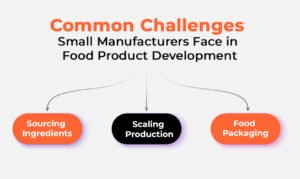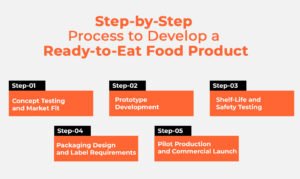Demand for ready-to-eat food products has gone up consistently as consumers seek meals that are fast, convenient, and still appear to be natural food. Such a change has allowed a true growth path to be created for small and mid-size brands. Which, by being innovative with focus and having the ability to get high-quality products into the market faster than big manufacturers, have a competitive advantage.
Essentially, this is a statement of consumer readiness for better Ready-to-Eat food solutions, while the producers who will construct their brands thoughtfully are the ones that will gain the shelf.
Common Challenges Small Manufacturers Face in Food Product Development
Typically, the eagerness coming from the launch of the Ready-to-eat concept collides with reality pretty fast. All these issues, such as sourcing of ingredients, food safety, and scaling decisions, come at a small team that is often stretched in different directions. However, none of these challenges is a break of the great company. They are just the signs of a company in the early stages of growth, and the whole process becomes simpler once you know them.
Sourcing Ingredients
Consistency is the biggest hurdle here. You need ingredients that show up on time, match your quality specs, and stay within budget. Having two or three supplier options early prevents production headaches later.
Scaling Production
Let’s break it down. A recipe that works beautifully in a test kitchen rarely behaves the same in a 300-gallon batch. Scaling requires tight controls, good documentation, and equipment that can hit the same results every time. Without that, your cost per unit can spike.
Food Packaging & Labelling Requirements
Food Packaging & labelling rules can feel overwhelming because they touch everything from shelf-life to allergen statements. Treat compliance as part of your core ready-to-eat food development plan. It’s not something you fix at the end; it shapes how your product moves through the supply chain.
Get your Ready-to-eat products made by Foodsure, the best food production company.
Step-by-Step Process to Develop a Ready-to-Eat Food Product
A clear, repeatable process keeps you from reworking expensive steps. Here’s the structure that helps most brands move from idea to launch with confidence.
Concept Testing and Market Fit
Start simple. Determine if your idea actually solves a problem for a real customer. Getting honest feedback right now will save you a lot of tweaking later.
Prototype Development
This is the point where your idea turns into an actual product. Construct prototypes that incorporate your real components and replicate your planned production process. If the product works only when a single person makes it by hand, then it is not yet at the scaling stage.
Shelf-Life and Safety Testing
Shelf-life work is not only about how long the product lasts. It is about getting to know the behavior of your formula when it is subjected to stress, heat, time, distribution, and transport. Safety tests provide the information that is necessary to keep both your customers and your brand safe.
Packaging Design and Label Requirements
Your packaging performs a double function. First, to safeguard the product, and second, to convey trust. While designing, ensure that your labels comply with regulations in terms of nutrition panels, allergen calls, and handling instructions. Intelligent packaging maintains freshness and saves from the trouble of recall.
Pilot Production and Commercial Launch
A pilot run is your first chance to try out your process on a scale that is still quite manageable. You work out the batch sizes, the equipment settings, and the quality checks. When things go right with the pilot run, you can proceed with a limited commercial launch.
When Should You Bring in a Food Consultant
You’ll know it’s time for a Food Consultant when you’re burning hours solving the same problems instead of making progress. A great food consultant takes the uncertainty out of things like product formulation, shelf-life, compliance, and food production planning. They make the way to market much quicker because they have already dealt with the problems that you are encountering. The use of expert knowledge at the beginning is, most of the time, a better saving than the cost.
Final Thoughts
Ready-to-eat meals can significantly increase your sales volume if you develop them with a clear plan, proper testing, and support at the right time. The whole journey gets easier when you intentionally build, and the end product is of higher quality and attracts more consumers from the shelf.
Are you planning to launch your next Ready-to-eat concept? Then, book a free consultation with the best food consultants today! Reach Foodsure at +91 8130404757 to access all the information and services you need to make your ready-to-eat brand the one choice for everyone.
Frequently Asked Questions
How to manufacture ready-to-eat food?
Ready-to-eat food is made by preparing ingredients, cooking or processing them, ensuring they are safe, packaging them hygienically, and sealing them so they stay fresh without extra cooking.
What are the 4 types of product development?
The four types are:
- New product creation
- Product improvement
- Product line extension
- Product repositioning
What are the 7 stages of the product development process?
- Idea generation
- Idea screening
- Concept development
- Business analysis
- Product development
- Testing
- Launch
What is the food product development process?
It involves creating a new food item by researching the market, developing recipes, testing for taste and safety, improving the formula, designing packaging, and launching it.
Who produces 70% of the world’s food?
Small-scale farmers and local food producers around the world grow about 70% of the global food supply.
What are the 4 stages of product development?
- Brainstorming ideas
- Designing and planning
- Creating the product
- Launching it to the market
What are the 5 steps of the development process?
- Idea creation
- Planning
- Development
- Testing
- Release
What are the 4 stages of food processing?
- Cleaning and sorting
- Preparation
- Processing or cooking
- Packaging and storage

